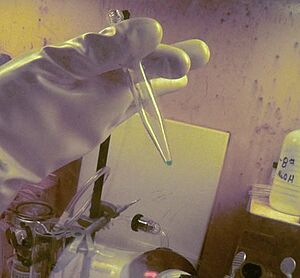Ununseptium facts for kids
Ununseptium (also called element 117) is a very heavy, man-made chemical element. Its temporary symbol is Uus, and its atomic number is 117. This means each atom of ununseptium has 117 protons. It is one of the heaviest elements ever made.
Ununseptium is found in group 17 of the periodic table, along with the halogens. Scientists don't know all its properties yet. They think it might be a metalloid, which is a type of element that has properties of both metals and nonmetals. Its boiling point, melting point, and how easily it loses electrons (called ionization energy) are expected to follow the patterns of the periodic table. Scientists from Russia and the United States worked together to discover ununseptium in 2010. It was the newest element discovered as of 2016.
Contents
How Element 117 Was Discovered
Planning the Experiment
In 2004, a team of scientists at the Joint Institute for Nuclear Research (JINR) in Dubna, Russia, wanted to create element 117. To do this, they planned to combine two other elements: berkelium (element 97) and calcium (element 20).
However, the American team at Oak Ridge National Laboratory was the only place in the world that made berkelium. They had stopped making it for a while. So, the Russian team first made element 118 using californium (element 98) and calcium instead.
The Russian scientists really wanted to use berkelium. This is because the special type of calcium they used, called calcium-48, has 20 protons and 28 neutrons. This makes it a very stable and light atom with more neutrons than protons. When they combine berkelium (97 protons) with calcium (20 protons), they get an atom with 117 protons.
In the experiment, the berkelium is made into a thin sheet called a "target." The calcium is then shot at this target as a fast-moving "beam." The calcium beam is made in Russia by carefully taking out the small amount of calcium-48 from natural calcium.
The new, heavier atoms created in this experiment are thought to be closer to something scientists call the "island of stability." This is a theory that some very heavy atoms could be quite stable, even though most superheavy elements break apart quickly.
Making and Transporting Berkelium
In 2008, the American team started making berkelium again. They told the Russian team that they had made 22 milligrams of it. This was just enough for the experiment.
After it was made, the berkelium had to be cooled and cleaned. This took about 180 days. The berkelium target then needed to be sent to Russia very quickly. This is because the special type of berkelium they used, berkelium-249, has a half-life of only 330 days. This means that after 330 days, half of the berkelium would have changed into another element. If the experiment didn't start within six months, there wouldn't be enough berkelium left.
In the summer of 2009, the berkelium target was put into five special lead containers. It was then sent on a regular flight from New York to Moscow.
Both teams had to deal with a lot of official paperwork between America and Russia to make sure the berkelium arrived on time. But there were still problems! Russian customs stopped the berkelium target from entering the country twice because of missing papers. Even though the target crossed the Atlantic Ocean five times, the whole trip only took a few days.
Once the target finally got into Moscow, it was sent to Dimitrovgrad. There, the berkelium was placed onto a thin layer of titanium. This film was then taken to Dubna and put inside the JINR particle accelerator. This machine is the most powerful in the world for creating superheavy elements.
The Discovery
The experiment began in June 2009. In January 2010, the scientists at the Flerov Laboratory of Nuclear Reactions announced that they had found evidence of a new element: element 117. They saw it break down (or decay) in two different ways.
On April 9, 2010, an official report was published in a science magazine called Physical Review Letters. It showed that the new forms of element 117 they found were called 294Uus and 293Uus. These were made by combining berkelium and calcium like this:
- 249Bk + 48Ca → 297Uus* → 294Uus + 3 n (This happened 1 time)
- 249Bk + 48Ca → 297Uus* → 293Uus + 4 n (This happened 5 times)
Images for kids
See also
 In Spanish: Teneso para niños
In Spanish: Teneso para niños




